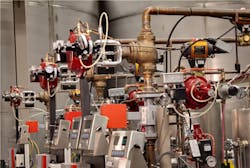Precision and quality are critical requirements for flow measurement instruments, no matter what the application or industry. From metering residential and industrial water use to measuring flowrate in water treatment, wastewater, chemical, food and beverage, and many other applications, accuracy is essential.
As a producer of flow measurement solutions, Badger Meter employs comprehensive product development and testing at its Milwaukee headquarters in the James O. Wright Innovation Center—one of the largest cold water testing facilities in the world.
At the Innovation Center, Badger Meter replicates the water sources found in residential, commercial and industrial applications using a reservoir with 125,000 gallons of water, assorted pumping systems, and a weir tower. From basic mechanical functionality to network connectivity, products undergo rigorous testing and improvement processes using extreme and strict standards to ensure exacting, reliable operation.
Photo courtesy of Badger Meter (www.badgermeter.com)
Control Valves & Magmeters Are Essential to Product Testing
Research control valves and electromagnetic meters (magmeters) are installed on all flow test lines in the center’s Hydro Lab. The Hydro Lab includes nine operational test stands designed specifically for testing meter accuracy using gravimetric standards.
The control valves and magmeters are used to set and maintain flowrates for meter testing. With their high accuracy rating and dependability, magmeters are well suited for flowmetering tests. The magmeters present very little pressure loss and operate over a wide range of flowrates, while an array of control valve offerings, with the flexibility for customization, easily meets the wide flow range required to test various meter sizes.
How Flow Tests Determine Meter Accuracy
The magmeter, which consists of a detector within the flowstream and an amplifier for processing the information, is used as a reference meter for controlling the flowrate of water passing through the test stand. Based on the magmeter’s reading, a technician opens or closes a control valve to adjust the flowrate up or down, repeating the process until the targeted flowrate for the test is displayed on the magmeter. The control valve then remains in this position for the duration of the accuracy test.
While the magmeter approximates the desired flowrate, the actual flowrate for any given test is determined by weighing the water after each test, applying temperature correction factors to determine its density, and dividing the calculated volume by the time over which the test occurred.
In addition to manual testing, certain test stands are designed for automated meter testing. For an automated accuracy test the meter must have a register capable of outputting real-time data or, alternately, have an encoder installed in place of the register to perform this function. A programmable logic controller (PLC) is utilized to set the flowrate using data from the reference magmeter. It also instructs the control valve to open or close to adjust the flowrate, begins and stops the test, collects the data from the meter output and scale, and calculates as well as records the test results.
Magmeters are well suited for most water applications, including potable water, wastewater, or reclaimed water. They will measure bi-directional flow and perform well in many chemical, pharmaceutical, and food and beverage applications, as long as the fluid is somewhat electrically conductive.
Research Control Valves Provide Exacting Precision
Control valves that meet the wide flow range required to test meter sizes, ranging from 0.25 to 2 inches, are used exclusively on the small meter accuracy test stands to precisely control the flowrate. Without this precision, it is difficult to replicate exact flowrates from one test to another. Three Badger Meter Research Control Valves are typically installed on each small meter accuracy test stand. A single Series 9100 Valve is used to control the higher flowrates on the stands and two smaller Research Control Valves are used to control low and ultra-low flows. Standard valves are used with custom trims selected to specifically meet targeted flow ranges. In addition, the valves communicate with the test stands’ PLC to set and maintain the flowrate when used in the automatic test mode.
In the 12 years the Innovation Center has been open, Badger Meter engineers have needed to perform only minimal service to the magmeters and research control valves.


